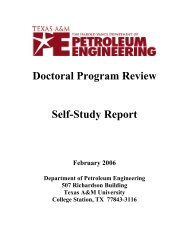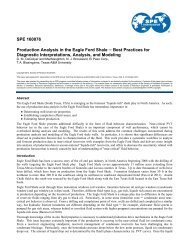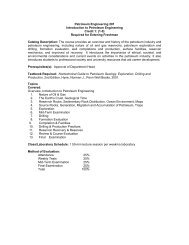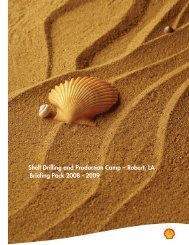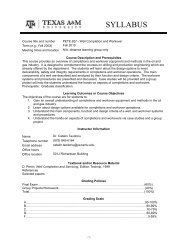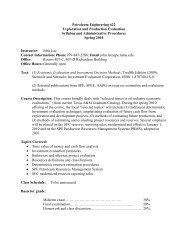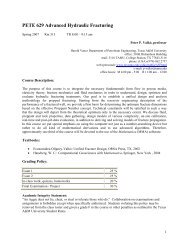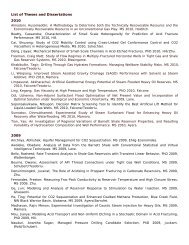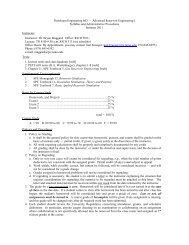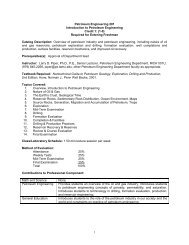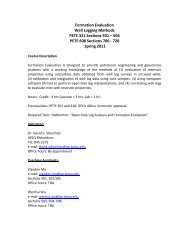Crisman Annual Report 2009 - Harold Vance Department of ...
Crisman Annual Report 2009 - Harold Vance Department of ...
Crisman Annual Report 2009 - Harold Vance Department of ...
Create successful ePaper yourself
Turn your PDF publications into a flip-book with our unique Google optimized e-Paper software.
Fracture Aperture Variation Caused by Reactive Transport <strong>of</strong> Silica and<br />
Poro-Thermoelastic Effect<br />
Introduction<br />
Poro-thermo-mechanical processes and<br />
mineral precipitation/dissolution change the<br />
fracture aperture and thus affect the fluid<br />
flow pattern in the fracture.<br />
a.<br />
t =3 months<br />
b.<br />
t =3 months<br />
Different aspects <strong>of</strong> thermal and mechanical<br />
processes have been studied (e.g. Ghassemi<br />
and Zhang, 2004; Ghassemi et al., 2005,<br />
2007, 2008, and <strong>2009</strong>). The thermoelastic<br />
effects are dominant near the injection when<br />
compared to those <strong>of</strong> poroelasticity. Under<br />
some conditions, silica reactivity tends to<br />
dominate permeability (Kumar and Ghassemi,<br />
2007). Experimental studies (Carroll et al.,<br />
1998; Johnson et al., 1998; Dobson et al.,<br />
2003) also show that chemical precipitation<br />
and dissolution <strong>of</strong> minerals significantly affect<br />
fracture aperture.<br />
c. t =3 months<br />
d.<br />
t =3 months<br />
Objectives<br />
We will study this phenomenon by the<br />
development and application <strong>of</strong> a threedimensional<br />
poro-thermoelastic model<br />
incorporating mineral dissolution/precipitation<br />
effects.<br />
Approach<br />
Simulating the poro-thermoelastic chemical<br />
mechanisms usually requires solving a coupled set<br />
<strong>of</strong> equations (e.g., fluid flow, heat transport, solute<br />
transport/reactions and elastic response <strong>of</strong> the<br />
reservoir). These processes are coupled and nonlinear.<br />
In this work, the solid mechanics aspect <strong>of</strong><br />
the problem is treated using poro-thermoelastic<br />
displacement discontinuity method (Ghassemi et<br />
al., <strong>2009</strong>), while reactive flow and heat transport in<br />
the fracture is solved using finite element method.<br />
Similarly, the solution system in the reservoir rock<br />
is obtained using the boundary element method. We<br />
focus on single-component mineral reactivity and<br />
its transport in the fracture. The solute reactivity<br />
and solubility in fracture plane is considered using a<br />
temperature dependent formulation (e.g., Robinson,<br />
1982, and Rimstidt and Barnes, 1980).<br />
Significance<br />
We apply the model to simulate the process <strong>of</strong><br />
low-temperature fluid injection and production <strong>of</strong><br />
high-temperature fluid in a hot-rock-reservoir, and<br />
a. Flow vector in planar fracture; b. Contour plot <strong>of</strong> the temperature (K) distribution;<br />
c. Contour plot <strong>of</strong> silica concentration (ppm) in the fracture; d. Ratio <strong>of</strong><br />
current fracture aperture to the initial fracture aperture.<br />
thus its impact on mineral mass distribution, pore<br />
pressure and thermal stress. Recent computations<br />
include temporal evolution <strong>of</strong> mineral concentration<br />
and its dissolution/precipitation, temperature, and<br />
fluid pressure in the fracture.<br />
Project Information<br />
2.5.14 Fracture Aperture Variation due to Reactive Transport<br />
<strong>of</strong> Silica and Poro-Thermoelastic Effect<br />
Related Publications<br />
Rawal C. and Ghassemi A. A 3-D Analysis <strong>of</strong> Solute<br />
Transport in a Fracture in Hot- and Poro-elastic Rock. Paper<br />
to be presented at the 2010 44th U.S. Rock Mechanics<br />
Symposium, ARMA, Salt Lake City, Utah, 27-30 June.<br />
Rawal C. and Ghassemi A. Reactive Flow in a Natural<br />
Fracture in Poro-thermoelastic Rock. Paper presented at<br />
the 2010 35th Stanford Geothermal Workshop. Stanford,<br />
California, 1-3 February.<br />
Contacts<br />
Ahmad Ghassemi<br />
979.845.2206<br />
ahmad.ghassemi@pe.tamu.edu<br />
Chakra Rawal<br />
CRISMAN INSTITUTE<br />
62<br />
<strong>Crisman</strong> <strong>Annual</strong> <strong>Report</strong> <strong>2009</strong>



